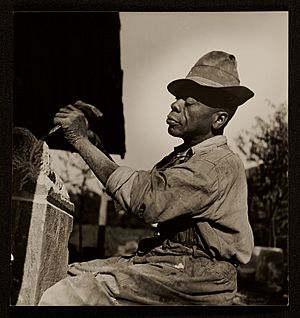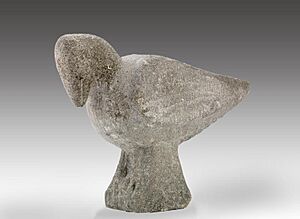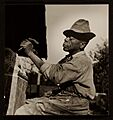William Edmondson facts for kids
William Edmondson (born around 1874–died 1951) was a very special African-American folk art sculptor. He was the first Black artist to have his own art show at the famous Museum of Modern Art (MoMA) in New York City in 1937.
Contents
About William Edmondson
William Edmondson was born in December 1874 on a plantation in Davidson County, Tennessee. He didn't know his exact birthday because a fire destroyed his family's Bible. William was one of six children born to Orange and Jane Edmondson. His parents had been enslaved before they became sharecroppers, working on farms for a share of the crops.
On the plantation, William's family worked hard in the corn fields and with animals. He often saw what he called "angels in the clouds" and felt that God was speaking to him. William didn't get much formal schooling.
When his father passed away in 1889, 16-year-old William decided to leave the plantation. He moved to Nashville and found a good job at the large Nashville, Chattanooga and St. Louis Railroad shops. In 1907, after an injury, he started working as a janitor at the Nashville Women's Hospital. He stayed there until the hospital closed in 1931.
William bought a small house and a big yard in Edgehill, a neighborhood in Nashville. He never got married. He shared his home with his mother, sister, and sometimes other family members. After his mother, Jane, died in 1922, his sister Sarah took care of the house. She was known for hosting fun family barbecues with lots of laughter and stories. When the hospital closed, William took on different part-time jobs. In his free time, he sculpted in his backyard and sold vegetables.
William stopped sculpting in 1948. He passed away quietly at home in Nashville on February 7, 1951, at age 76. His nieces and nephews held his funeral. William was buried in Mount Ararat Cemetery, which is now Greenwood Cemetery (Nashville, Tennessee). Sadly, his grave marker is gone today. Back then, cheap wooden caskets were used for Black Americans, and as the wood decayed, the markers would sink. Also, the burial records from that time were lost in a fire, so his exact grave spot is unknown.
William's Art Journey
William Edmondson started sculpting when he was about 60 years old in 1934. He said that God told him to start. He explained, "I was out in the driveway with some old sculptures of stone when I heard a voice telling me to pick up my tools and start to work on a tombstone." He felt it was a clear message from God.
He mostly carved tombstones from pieces of limestone that came from old, torn-down buildings. Trucks would deliver these stones to him. His tombstones often had strong, large letters carved into them. He sold or gave these tombstones to friends and family. Soon, he also began making lawn decorations, birdbaths, and other sculptures. He even had a sign in his yard that said, "Tomb-Stones. For Sale. Garden. Ornaments. Stone Work W M Edmondson."
William's art was deeply connected to his Christian faith and his church. His sculptures were simple yet powerful. They were usually one to three feet tall and often showed his unique religious ideas. He carved figures of people from the Bible, angels, doves, turtles, eagles, rabbits, horses, and other real or imaginary animals. His sculpture Noah's Ark was a tall piece in his backyard, made of four different carved limestone sections.
He also carved figures of important people in his community, like preachers and teachers. He even sculpted famous figures like the boxer Jack Johnson and First Lady Eleanor Roosevelt. Many of his carved figures had round faces with a small mouth right under a vertical nose, connecting to the curve of the brow. Sometimes, he would make the nose wider or skip the eyebrows. It's thought he did this to include different kinds of people in his art. A common feature of his sculptures was their strong, solid shapes. He also used different textures, making some parts smooth, chiseled, polished, or rough. You can see these details in his well-known works like Bess and Joe and Mary and Martha.
William's art was popular in his neighborhood. Many of his sculptures were displayed in his yard and in the yards and gardens of his neighbors. A few years after he started sculpting, an art lover named Sidney Hirsch from Peabody College discovered William's large collection of sculptures. Hirsch loved art from different cultures and became a big supporter of William.
Through Hirsch, other wealthy people in Nashville bought William's sculptures for their homes and gardens. Many of these works were later shown in museums like the Smithsonian American Art Museum. Alfred and Elizabeth Starr, who were friends of Hirsch, also became big fans of William's art. They introduced William to their artist friends, including photographer Louise Dahl-Wolfe. Louise took over a hundred photos of William working in his backyard. She tried to get his work published in Harper's Bazaar magazine, but some people in charge weren't ready to show art by Black artists at that time. So, Louise showed William's work to Thomas Mabry and Alfred Barr, the director of the Museum of Modern Art (MoMA).
William Edmondson's art career lasted about 15 years. He didn't earn a lot of money from his art during his lifetime. In the late 1940s, his health got worse, and he sculpted less. He created about 300 works of art in his life.
Art Shows and Recognition
William Edmondson had his very own art show at the Museum of Modern Art from October 20 to December 1, 1937. This was a huge deal because he was the first African American artist to have a solo show there. In 1938, his sculptures were also shown in Paris, France, as part of a big art exhibition.
For a while, interest in his work grew, but then it slowed down. Some people saw him as just a "folk artist" or "self-taught." However, locally, Alfred Starr kept promoting William's art. Starr even introduced the famous photographer Edward Weston to William in 1941. Weston took many amazing photos of William working. In 1941, William also had another solo show at the Nashville Art Gallery.
After William passed away, his art was shown only sometimes in the 1950s and 1960s, often in "folk art" exhibits. In 1973, a book about him was published. His sculptures were included in a very important exhibition called "Two Centuries of Black American Art" in 1976. In 1981, the new Tennessee State Museum opened with a special permanent exhibit of six of William's sculptures.
Throughout the 1980s and 1990s, William's sculptures were shown a lot, but still often with labels like "outsider" or "self-taught." In 1999, Nashville's Cheekwood Museum of Art put together a major traveling exhibition of his work. This show helped people understand his life and art better. In 2006, an exhibition called "William Edmondson, Bill Traylor, and the Modernist Impulse" showed his art alongside another self-taught artist. This exhibit argued that William should be seen as a great artist without limiting labels. It displayed 21 of his sculptures, the largest collection of his art in the country. In 2016, the Smithsonian American Art Museum received three of William's sculptures as part of a large gift of folk art.
Today, William Edmondson's art is permanently displayed in many museums. These include the Newark Museum of Art, the American Folk Art Museum, the Hirshhorn Museum and Sculpture Garden, and the Smithsonian American Art Museum.
William Edmondson's Legacy
On August 20, 2014, Nashville opened its first arts park, named in honor of William Edmondson. The park is in a historically African-American neighborhood and features sculptures inspired by William's work. Even though William's old house is now a public school, it has a special Tennessee historical marker. A few miles away, some of the tombstones he carved can still be seen in a local cemetery.
Since his death, William Edmondson's work has become highly valued by art experts and collectors. His sculptures can sell for hundreds of thousands of dollars at auctions. In January 2016, one of his sculptures, "A Boxer," sold for $785,000, which is the highest price ever paid for a work by William Edmondson.
Selected Recent Exhibitions
- Cheekwood Museum of Art, Nashville, TN
- The Art of William Edmondson 1999 (with the American Folk Art Museum, New York, NY)
- William Edmondson and Friends: Breaking the Mold, 2014
Collections with Edmondson Works
- American Folk Art Museum, New York, NY
Images for kids





